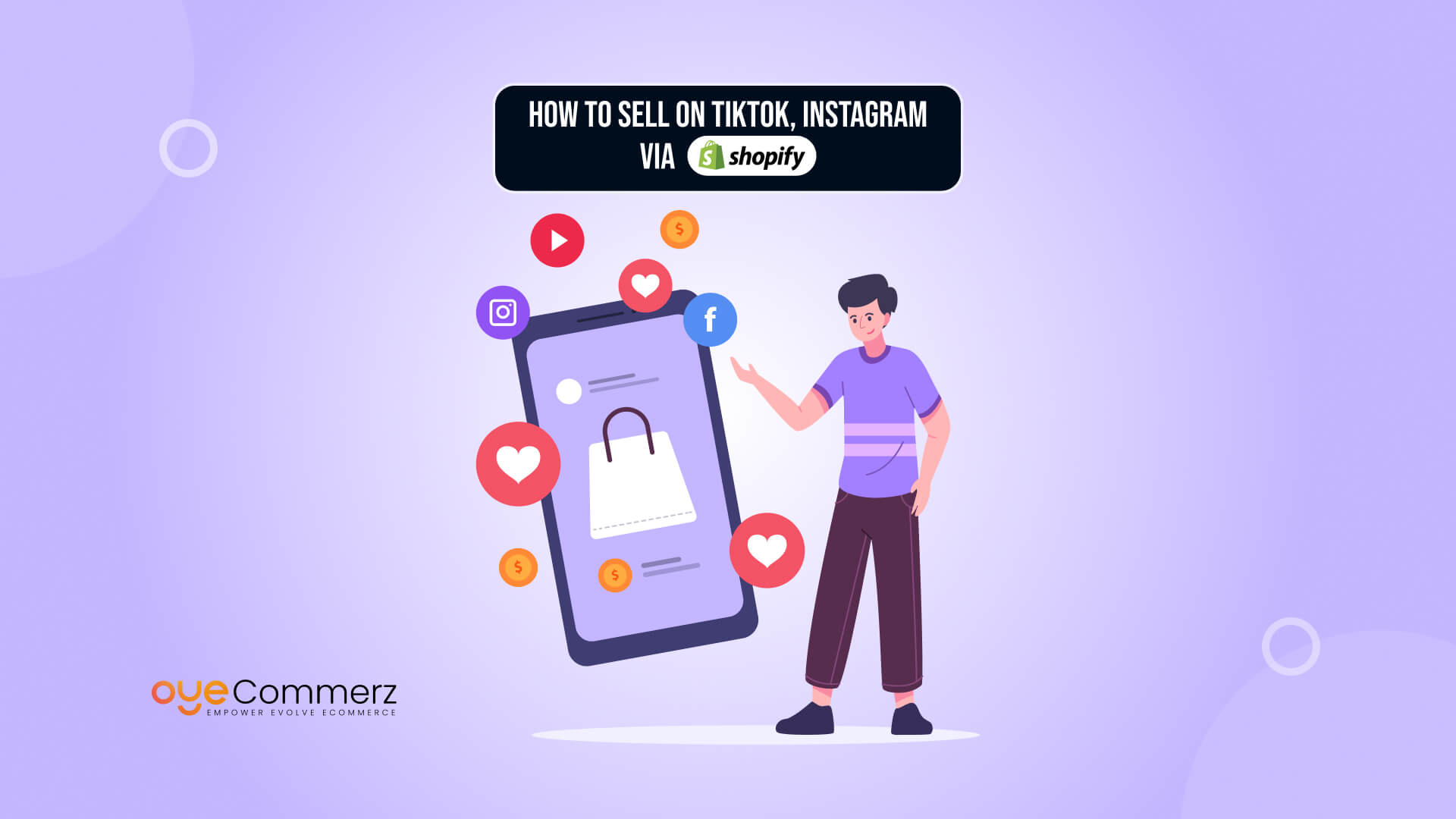Social commerce is reshaping the way we shop online. Unlike traditional eCommerce, which relies on search engines and standalone websites, social commerce brings products directly into the social media experience, blending content, community, and commerce. It’s not just about ads; it’s about making purchases seamless within the platforms people already use daily.
TikTok and Instagram are leading this shift. As discovery-first platforms, they capture attention through short, engaging content and make it incredibly easy to turn interest into instant sales. And behind the scenes, Shopify is powering this transformation, connecting brands to these platforms, managing inventory, and enabling smooth checkouts.
In this blog, we’ll explore how businesses can sell effectively on TikTok and Instagram using Shopify. You’ll learn platform-specific tactics, how to integrate your store. Whether you’re a beginner or scaling fast, the future of selling is here, and it’s social, simple, and full of opportunity.
Table of Contents
ToggleWhat is Social Commerce and Why Is It Booming?
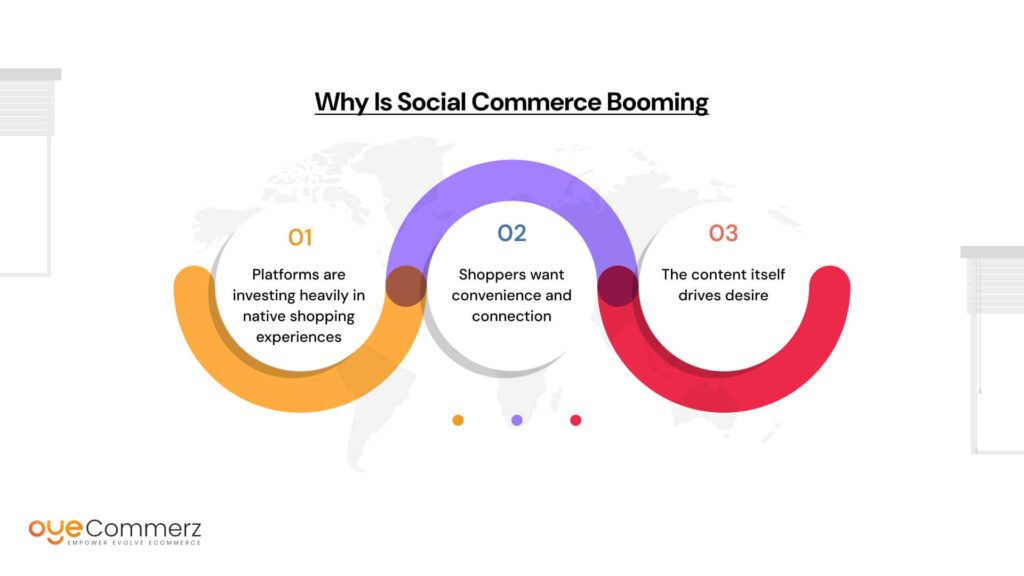
Social commerce is the next evolution of online shopping. While traditional eCommerce relies on users visiting standalone websites or online marketplaces like Amazon, social commerce integrates the entire shopping experience directly into social media platforms. Think of it as eCommerce happening where people are already spending their time, scrolling, liking, and discovering.
Here’s the key difference:
- Traditional eCommerce: Customers search for a product, land on a website, add to cart, and checkout.
- Social commerce: Customers discover products organically in their feed, watch a video or swipe through a post, and purchase instantly without ever leaving the app.
And the numbers speak for themselves. According to a 2023 report by Statista, over 110 million U.S. consumers made a purchase through social media platforms, and that number is expected to grow rapidly. Globally, it is projected to become a $2.9 trillion market by 2026.
So why is this happening?
- Platforms are investing heavily in native shopping experiences:
- Instagram offers full storefronts, shoppable posts, and checkout directly inside the app.
- TikTok has launched TikTok Shop and partnered with Shopify for seamless store integration.
- Facebook, Pinterest, and even YouTube are following suit, all aiming to reduce friction in the buying journey.
- Shoppers want convenience and connection:
- Today’s consumers, especially Gen Z and Millennials, want to shop from brands they trust and discover in authentic ways.
- Recommendations from influencers, user-generated content, and real-time reviews feel more organic than ads.
- The content itself drives desire:
- A well-shot product reel, tutorial, or trend-based TikTok can spark instant demand.
- People no longer “go shopping”, they shop while doing other things online.
Social commerce isn’t just a trend, it’s a shift in behavior. Brands that adapt to this wave early are not only meeting customers where they are but making buying effortless and enjoyable.
Why TikTok and Instagram Are the Social Commerce Giants
In the rapidly growing world of social commerce platforms, TikTok and Instagram have emerged as the most dominant forces. What sets them apart isn’t just their popularity, it’s how they blend entertainment, discovery, and shopping into a single, seamless experience.
Audience Demographics and Buying Behavior
- TikTok has a younger, more experimental audience. Around 60% of its users are Gen Z, who are highly influenced by trends, creators, and visual storytelling. They’re spontaneous shoppers who buy based on what feels authentic and exciting in the moment.
- Instagram appeals to a broader demographic, with strong engagement across Millennials and Gen Z. These users value aesthetic presentation, brand storytelling, and trust signals like reviews and influencer endorsements.
Consumers on both platforms are increasingly comfortable purchasing products without ever leaving the app, especially when they feel an emotional connection with what they see.
TikTok’s Strength: Short-form Discovery
TikTok’s algorithm is designed for discovery. Even small creators can go viral, and product recommendations often gain traction quickly. Features like:
- Shoppable TikTok videos
- TikTok Shop integrations
- “TikTok Made Me Buy It” trend
…all make it easy for users to stumble upon new products and purchase impulsively.
A makeup brush demo, a snack review, or a quirky gadget video can lead to thousands of real-time purchases. The key is that TikTok doesn’t rely on search—it delivers content to users based on interests and behavior, creating an ideal environment for product discovery.
Instagram’s Edge: Integrated Shopping Tools
Instagram has spent years refining its commerce tools:
- Instagram Shops allow full storefronts within the app
- Reels and Stories include shoppable product tags
- Product launches and drops build hype and urgency
Instagram’s visual-first design helps brands build trust and inspire buying decisions through polished content and lifestyle-driven visuals.
Authenticity and Influencer Impact
What fuels conversions on both platforms is authenticity. Influencers, micro-creators, and even real customers create content that feels genuine, whether it’s an unboxing, a tutorial, or a spontaneous reaction. Unlike polished ads, this content drives trust and immediate purchase behavior.
In short, TikTok and Instagram aren’t just places to scroll, they’re dynamic storefronts shaped by personality, trust, and storytelling.
Introduction to Shopify Social Integrations
Creating great content is just half the equation, the other half is enabling seamless, reliable shopping. That’s where Shopify comes in. As one of the leading eCommerce platforms globally, Shopify now offers powerful native integrations with both TikTok and Instagram, helping businesses bridge content and commerce effortlessly.
Shopify’s Native Integrations with TikTok and Instagram
Shopify’s partnership with TikTok and Meta (Instagram’s parent company) allows merchants to connect their stores directly to these platforms. This means:
- You can create and run shoppable TikTok ads and tag products in videos.
- On Instagram, you can sync your Shopify product catalog to create shoppable posts, Reels, and Stories.
- Both platforms allow you to track conversions and performance through Shopify’s analytics tools.
All this without any coding or complex setup. You simply install the sales channel apps from your Shopify dashboard, and you’re good to go.
Shopify’s Social Commerce Tools
Here’s what makes Shopify an essential tool-
Product Tagging: Tag products directly in your TikTok or Instagram content so users can shop instantly.
- Checkout Links: Generate direct purchase links that take users from content to checkout in one click.
- Data Tracking: Monitor performance metrics like click-through rates, sales, and ROI for each piece of content.
These tools make the shopping experience not only convenient for consumers but also deeply informative for brands looking to optimize content and sales strategies.
Benefits of Syncing Catalog and Inventory with Content
Keeping your inventory synced between Shopify and social platforms avoids customer frustration and backorders. It also:
- Ensures real-time updates on product availability
- Enables smooth fulfillment and customer communication
- Keeps your brand’s image consistent across all channels
Shopify as the Digital Storefront
Think of Shopify as the engine behind your visually engaging social presence. While TikTok and Instagram draw people in, Shopify handles the logistics: product management, secure payments, shipping, and tracking. It’s your back-end storefront, invisible to users but vital to delivering a flawless experience.
In essence, Shopify empowers creators and brands to turn attention into action, and action into lasting customer relationships.
How to Set Up Your TikTok Shop with Shopify
Selling on TikTok doesn’t require a huge ad budget or a viral influencer. With Shopify, setting up your TikTok Shop is surprisingly simple, and incredibly effective. Whether you’re a small business or a growing creator brand, this setup gives you direct access to one of the most engaged and purchase-ready audiences in today’s digital world.
TikTok has rapidly evolved into a leading social commerce platform, making it easier than ever to meet consumers right where they scroll. Thanks to Shopify’s seamless integration, you can now turn your content into conversions without any technical hassle.
Step-by-Step: Setting Up Your TikTok Shop via Shopify
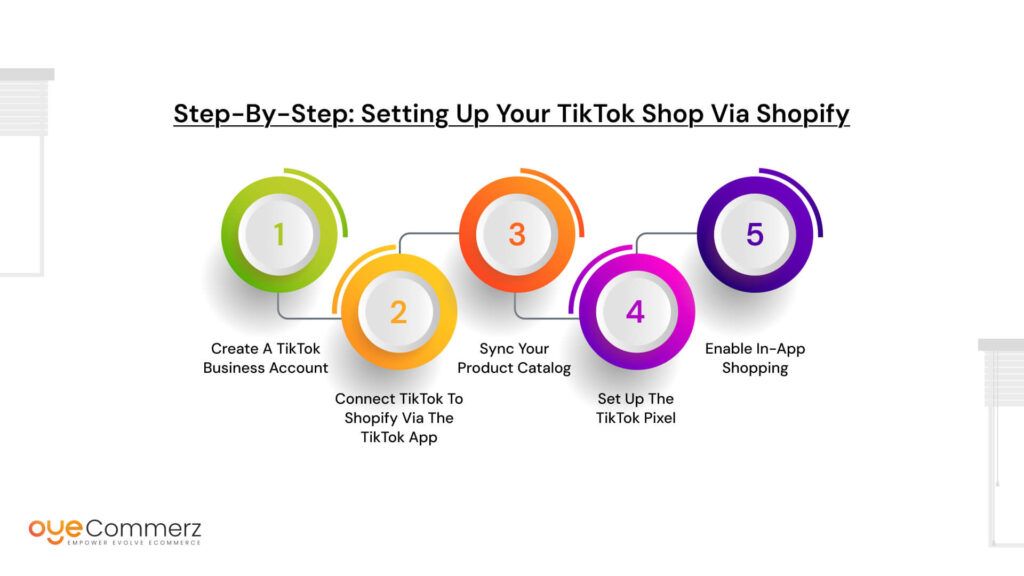
1. Create a TikTok Business Account
Visit TikTok for Business and sign up for a business account. This unlocks ad tools, analytics, and access to social commerce TikTok features.
2. Connect TikTok to Shopify via the TikTok App
- Head to the Shopify App Store and install the TikTok Sales Channel.
- Follow the prompts to securely link your TikTok Business account.
3. Sync Your Product Catalog
- Once connected, sync your Shopify product listings with TikTok.
- This allows you to tag products in videos, run dynamic ads, and manage inventory in real time.
4. Set Up the TikTok Pixel
- Shopify makes adding TikTok’s tracking pixel quick and easy.
- This helps you track user actions, measure ad performance, and retarget viewers who engage with your content.
5. Enable In-App Shopping
- Activate TikTok Shop so users can explore and purchase your products within the app.
- Ensure your product titles, descriptions, and images are polished and persuasive.
Tips on TikTok Content Strategy
TikTok is not just a platform, it’s a culture. Winning at social commerce TikTok means making content that feels native, honest, and engaging:
- Educational: Show how your product solves a problem or enhances life.
- Entertaining: Use trending sounds, challenges, or humor to capture attention.
- Behind-the-scenes: Share the real story of your brand to build emotional connection.
Best Practices for TikTok Ads and Organic Promotion
- Keep videos short, the first 3 seconds are your hook.
- Use clear, simple CTAs like “Shop now” or “See the link.”
- Boost top-performing content using Spark Ads for added reach.
- Stay consistent and reply to comments to nurture community trust.
As a social commerce platform, TikTok rewards originality and direct connection. When combined with Shopify’s backend power, you’re equipped to drive serious results, turning followers into buyers, and content into consistent revenue.
How to Sell on Instagram Using Shopify
Instagram isn’t just for inspiration, it’s one of the most powerful social commerce platforms for direct sales. With millions of users scrolling daily, it has evolved into a full-fledged shopping destination, especially for brands with strong visual identities.
When paired with Shopify, Instagram becomes more than just a showcase, it transforms into an efficient, seamless buying journey. From product discovery to checkout, everything can happen within the app, making it a top choice among rising social commerce platforms.
Step-by-Step: Setting Up Instagram Shopping via Shopify
1. Set Up Instagram Shop via Facebook Commerce Manager
- Go to Facebook Commerce Manager and create a shop connected to your Instagram Business Account.
- Connect your Shopify store using the Facebook & Instagram by Meta sales channel app on Shopify.
- Sync your product catalog from Shopify so your items appear as taggable products on Instagram.
2. Use Product Tagging in Every Format
Once your shop is live, make your products shoppable across various formats:
- Reels: Tag products in entertaining or educational short videos to drive impulse buys.
- Stories: Use product stickers and direct links to showcase limited-time offers or new arrivals.
- Feed Posts: Tag multiple products in a single image or carousel for an immersive browsing experience.
Instagram Checkout vs Link in Bio
One of the biggest shifts in social commerce Instagram is the ability to enable Instagram Checkout. This feature allows users to buy products without leaving the app, significantly reducing friction and cart abandonment.
However, if Instagram Checkout isn’t available in your region, linking to product pages via your bio or Story links (using Shopify’s smart URLs) remains effective.
Leverage Influencers, UGC, and Carousels
- Collaborate with creators to produce authentic user-generated content.
- Repost customer reviews, unboxing videos, or tutorials to build trust.
- Use shoppable carousels to group complementary products and tell a visual story.
Social commerce Instagram thrives on community, creativity, and consistency. With the right Shopify integration, every scroll can become a sale, and every post a potential checkout.
Content is Currency: Creating Content That Sells
In the world of social commerce, content isn’t just king, it’s currency. What you post can directly influence what people buy, and how fast they do it. But the secret isn’t high-end production. It’s content that feels native, relatable, and made for the platform, not just on it.
The 3 E’s of Conversion Content
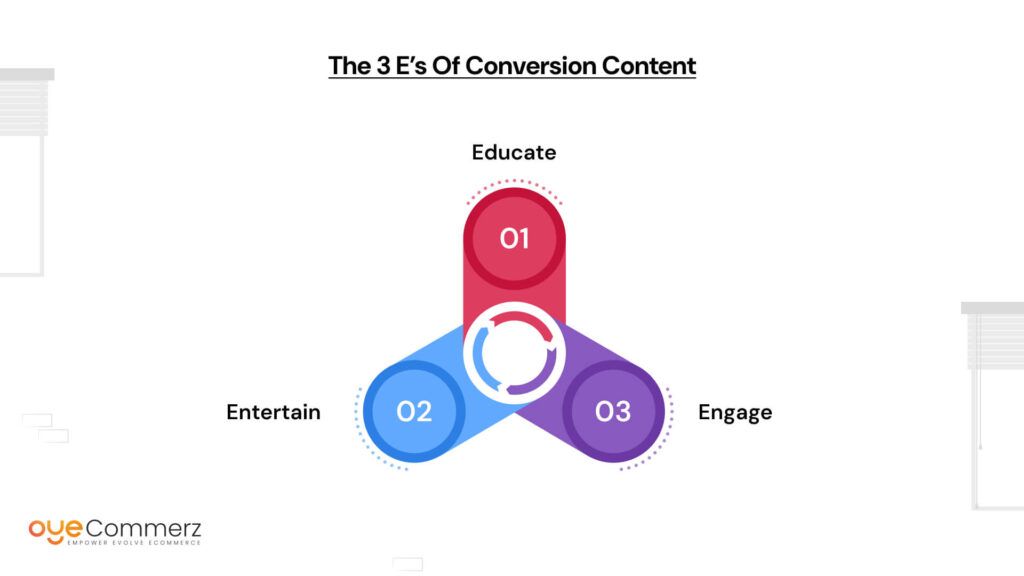
To truly sell without sounding salesy, your content should do at least one of the following:
- Educate: Teach users something useful about your product (e.g., how to use, how to style, how it helps).
- Entertain: Add humor, storytelling, or trends to make your content bingeable and memorable.
- Engage: Ask questions, respond to comments, and create space for interaction. The more people feel involved, the more likely they are to buy.
Native-Looking Content with Strategic Product Placement
Slick, ad-like videos often get skipped. Instead, blend your product into everyday moments. Think: “Get ready with me” videos, “day in my life” vlogs, or honest reviews with subtle product tagging. Content should feel like a friend’s recommendation, not a brand pitch.
Batch Creation Made Simple
Shopify now allows creators and merchants to draft and schedule content directly from its dashboard using connected apps. Use this to:
- Record and schedule Reels or TikTok in batches
- Pre-load product tags before publishing.
- Track performance and optimize future content.
Reels That Scaled a Beauty Brand
Let’s say there is a cosmetics brand that grew 2.5x in monthly revenue just by committing to 3 Reels per week. Each short video followed one of the 3 E’s, showing how to apply a product, adding trending audio, or answering skincare questions. With each Reel tagged through Shopify, viewers could shop without ever leaving Instagram.
The takeaway? High-performing content is consistent, helpful, and native to the platform it lives on.
Influencers, Affiliates & UGC: Driving Traffic to Shopify
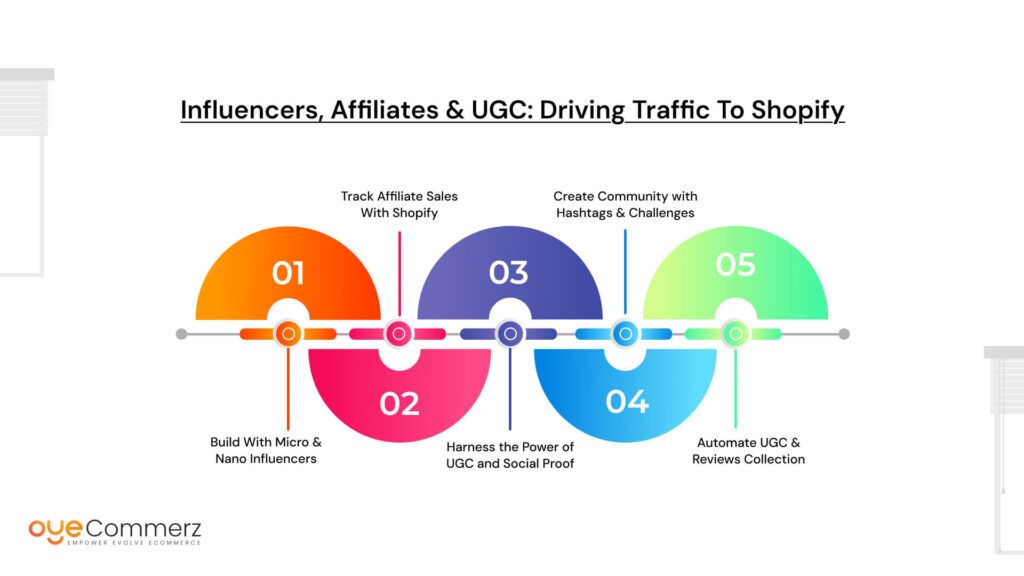
Trust drives conversion. And on social media, that trust often comes not from brands, but from people. Micro-influencers, customers, and creators all play a critical role in helping your Shopify store grow organically.
Build With Micro & Nano Influencers
You don’t need a celebrity endorsement. Often, accounts with 5K–50K followers drive more conversions because they have loyal, engaged communities.
- Use influencer platforms or manual outreach to connect.
- Offer a free product, a discount code, or a flat-rate fee.
- Let them create content in their voice—but ensure your brand is clearly linked.
Track Affiliate Sales With Shopify
With apps like Collabs or Refersion, you can track every sale influencers bring in.
- Assign each influencer a unique affiliate link or code.
- View performance in real-time via your Shopify dashboard.
- Reward top performers to build lasting partnerships.
Harness the Power of UGC and Social Proof
User-generated content works because it’s authentic. Real people, real results, real trust.
- Encourage happy customers to tag you in posts and Stories.
- Feature UGC in your product pages and ads to increase credibility.
- Turn reviews into short-form content snippets for TikTok or Instagram.
Create Community with Hashtags & Challenges
Especially on TikTok, challenges and branded hashtags create buzz and participation.
- Launch a simple challenge that uses your product (e.g., #7DayGlowTest for skincare).
- Incentivize participation with giveaways or features.
- Track all content under one tag for easy reposting and UGC collection.
Automate UGC & Reviews Collection
Use tools like Loox or Judge.me on Shopify to automate review requests post-purchase.
- Offer a discount on the next purchase for photo or video submissions.
- Embed this content on your storefront and social channels.
In the era of social commerce, your customers and creators are your marketing team. Tap into their voices and watch your traffic and grow.
Data, Optimization & Retargeting: Making Every Click Count
In social commerce, every view, click, and scroll offers insight, and opportunity. Shopify’s built-in analytics help you measure what matters most: product clicks, add-to-cart rates, and conversions tied directly to platforms like TikTok and Instagram.
Smart Optimization Strategies:
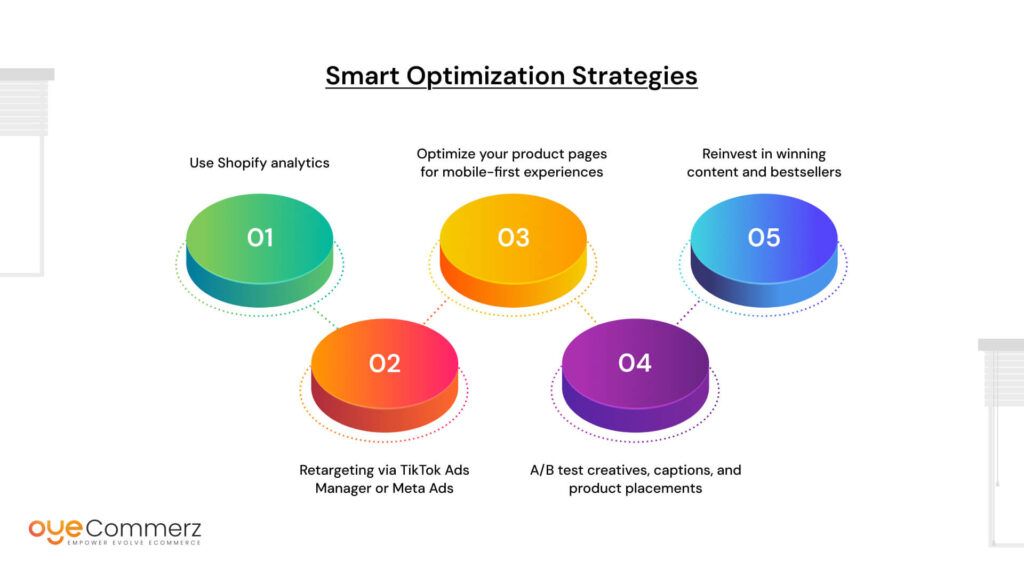
- Use Shopify analytics to identify top-performing products and content sources. Refine based on engagement and sales trends.
- Retargeting via TikTok Ads Manager or Meta Ads lets you re-engage users who viewed but didn’t purchase, turning interest into action.
- Optimize your product pages for mobile-first experiences. Clear images, fast loading speeds, and seamless checkout make the difference.
- A/B test creatives, captions, and product placements. What works on TikTok might not click on Instagram, and vice versa.
- Reinvest in winning content and bestsellers. Boost top Reels, reuse viral TikTok, and restock high-converting items.
By leveraging data and refining your approach in real-time, social commerce becomes less of a guessing game, and more of a smart, scalable growth engine.
Common Pitfalls to Avoid in Social Commerce
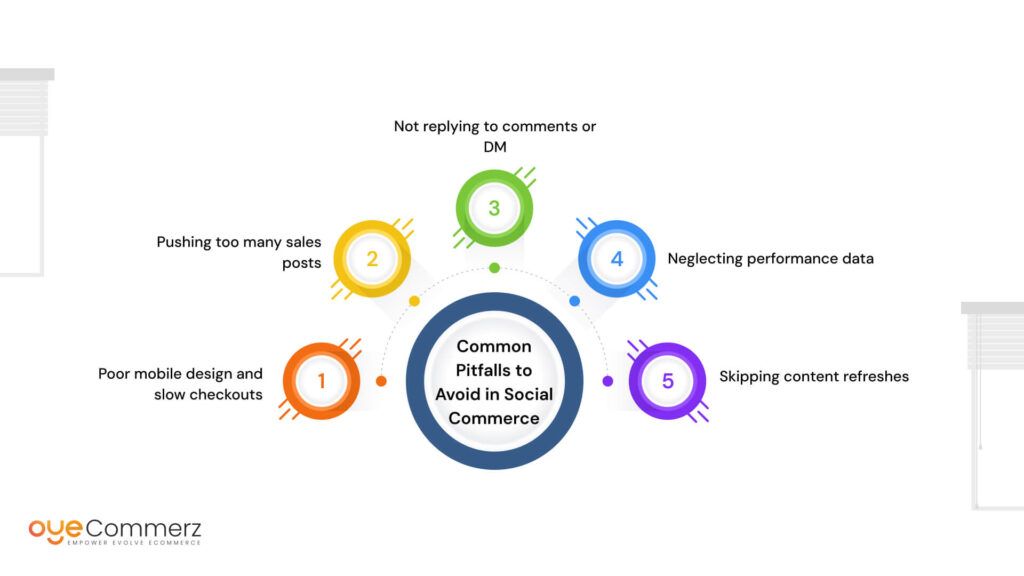
Even on the best social commerce platforms, mistakes can hold you back. To thrive, businesses must prioritize agility, engagement, and user experience, especially on mobile.
Avoid These Costly Missteps:
- Poor mobile design and slow checkouts turn away impulse buyers. Ensure your Shopify store is optimized for mobile from top to checkout.
- Pushing too many sales posts can feel spammy. Mix promotional content with value, how-to’s, behind-the-scenes, and UGC.
- Not replying to comments or DMs signals poor customer care. Active responses build trust, increase visibility, and nudge users toward purchase.
- Neglecting performance data means missing opportunities. Use Shopify and platform insights weekly to update your content and strategy.
- Skipping content refreshes can make your feed feel stale. Adapt to trends and platform updates regularly.
Social commerce is dynamic. Brands that listen, tweak, and stay connected to their audience will continue to grow, even in a crowded digital space.
Ready to turn scrolls into sales?
Join OyeCommerz and unlock the full power of social commerce for your brand. From TikTok to Instagram, we help you connect, convert, and grow, seamlessly.
Start your journey today and let your content do the selling. Your storefront is just a click away!
Contact to Migrate your Site to Shopify Now
Conclusion
Social commerce isn’t just a buzzword, it’s reshaping the future of digital retail. As consumer behavior shifts from search to scroll, platforms like TikTok and Instagram are becoming the new-age storefronts. They’re no longer just places for entertainment or inspiration, they’re thriving marketplaces where discovery meets instant purchase.
With Shopify acting as the backbone, bridging content and commerce has never been simpler. Whether you’re a creator, small business, or growing brand, the tools to succeed are accessible, flexible, and built for this era. You don’t need a massive budget or viral fame to begin, just a willingness to experiment, adapt, and connect authentically.
Now is the time to start small. Set up your Shopify store, create that first Reel or TikTok, and lean into the platforms your audience already loves. The future of commerce is social. And your next customer? They’re already scrolling. Don’t miss the moment, make it yours.
Frequently Asked Questions
Connect your Instagram Shop via Facebook Commerce Manager to Shopify, sync your catalog, and start tagging products in posts, Reels, and Stories.
Create a TikTok Business account, connect it to Shopify, sync your products, set up TikTok Shop, and start posting shoppable content.
As of 2024, TikTok’s global social commerce revenue is projected to surpass $20 billion, driven by in-app shopping features and creator-led sales.
It’s the integration of social media and eCommerce, allowing you to sell directly on platforms like TikTok and Instagram through your Shopify store.
Install the TikTok Sales Channel from the Shopify App Store, connect your TikTok Business account, sync products, and enable TikTok’s ad and shopping features.

